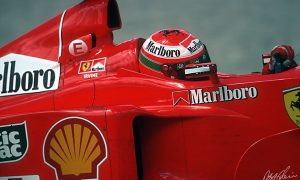
©F1i
UNDER PRESSURE
This rare image shows part of the admission system on the Mercedes power unit. A mechanic holds one of the two inlet manifolds; from the inlet plenum sprout three intake runners (one for each cylinder, on both sides of the V6). These channel the compressed and cooled air to the combustion chamber, while fuel is sprayed directly into it. Since 2015, F1 power units can be equipped with a variable length intake system, which is the case on the Mercedes plant.
Force India’s engine engineers remain part of Mercedes staff. Speaking to JAonF1, the German manufacturer explained that, as a power unit supplier, it provides its customer teams with “a phase document” that details how to operate the engine: how many laps it can do in such and such mode, the maximum revs, etc.
Analysing fuel and oil samples, which is carried out by experts from Mercedes’ engine factory at Brixworth, also enables them to refine engine appraisal and its “safe operating limits”.
Mercedes AMG High Performance Powertrains (HPP) thus delegate to each of its customer team “a programme manager, two power unit engineers, a senior power unit technician, two power unit technicians and an ERS technician”.
We have already mentioned Mercedes’ split-turbo design, with the turbine and compressor sitting on each side of the engine. The two elements are linked with a shaft that goes through the ‘Vee’ of the engine. Incidentally, the MGU-H is also placed in the heart of the V6.
That’s why one can see at the front of the engine (see top image), the orange cables used to connect the MGU-H to the control electronics (CE). On the right-hand side is part of the cable for the MGU-K/CE connection.






